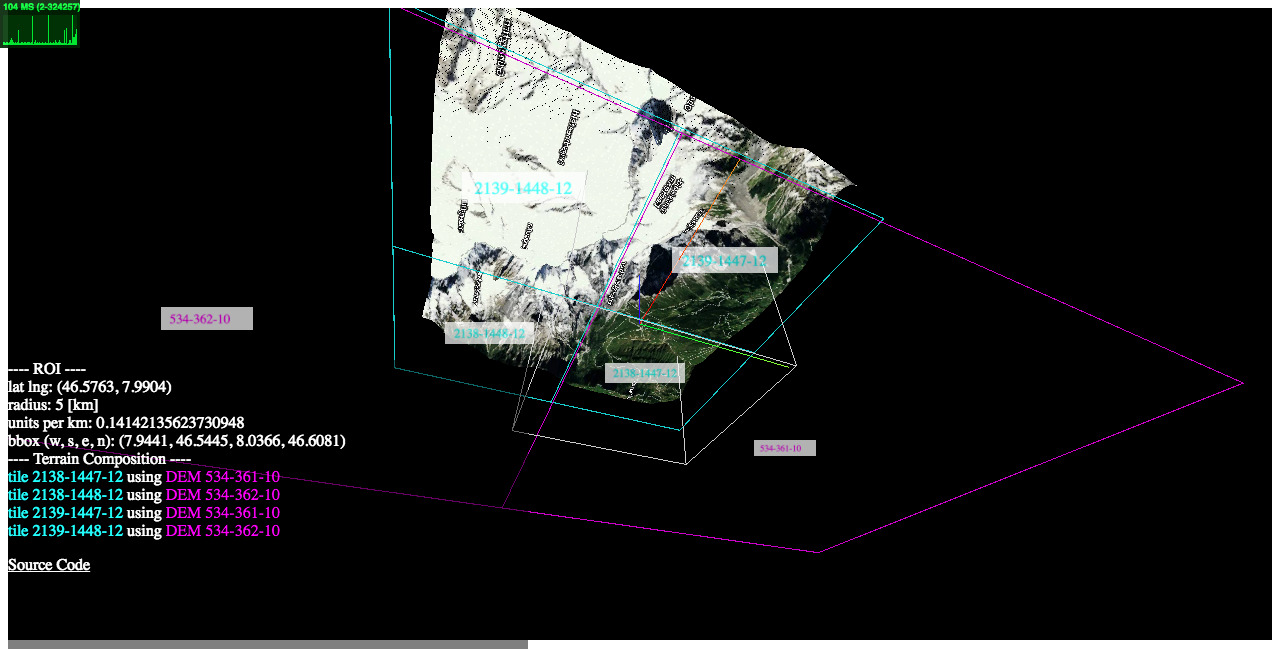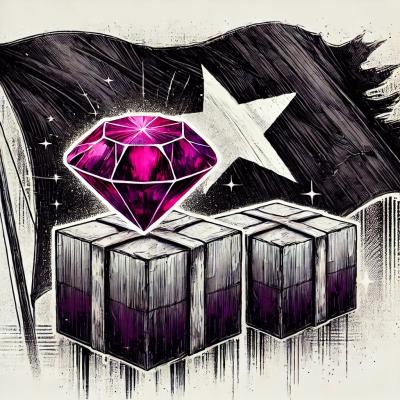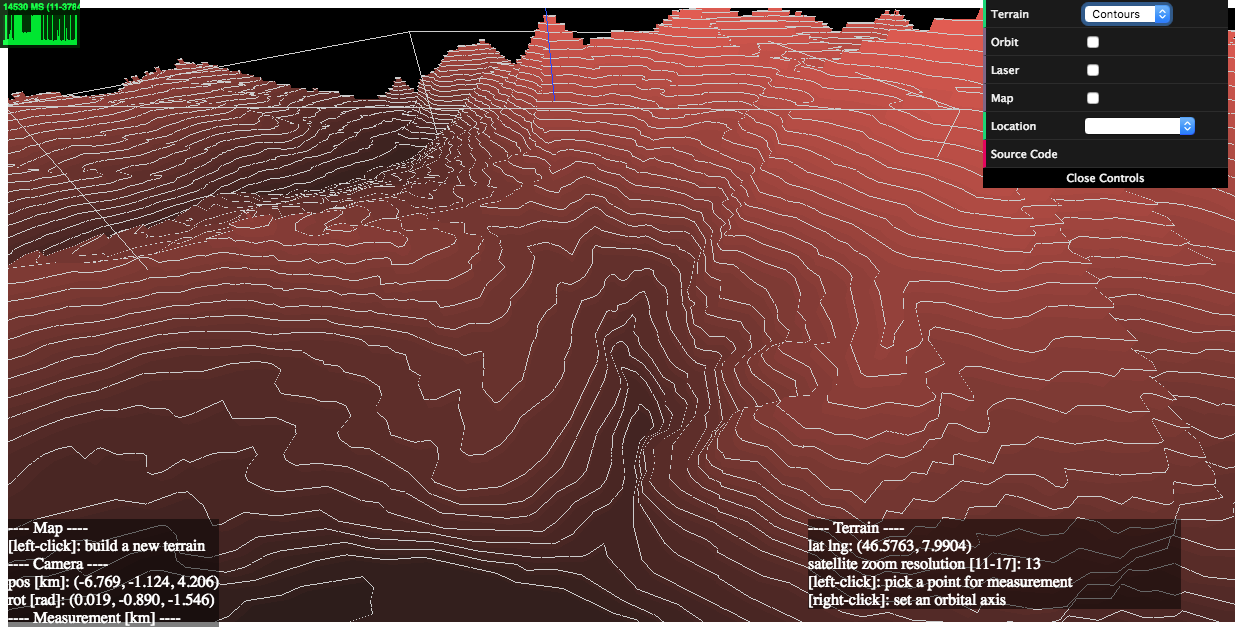three-geo



three-geo is a three.js based geographic visualization library. Using three-geo, we can easily build satellite-textured 3D terrain models in near real-time by simply specifying GPS coordinates anywhere on the globe. The geometry of the terrain is based on the RGB-encoded DEM (Digital Elevation Model) provided by the Mapbox Maps API.
The terrain is represented by standard THREE.Mesh objects. This makes it easy for us to access underlying geometry/texture array and perform original GIS (Geographic Information System) experiments in JavaScript. (See Usage for how to programatically obtain those mesh objects).
Credits: this library has been made possible thanks to
Demo
This demo app includes features such as
- on-demand 3D terrain building (by a mouse click on the Leaflet map),
- real-time camera projection onto Leaflet (with oritentaion and HFoV indication),
- terrain interaction with a VR-like laser beam,
- measuring Euclidean distances between terrain points,
- auto camera orbiting around the custom z-axis.
Live:
This demo illustrates the relationship between a reconstructed 3D terrain and its underlying satellite/DEM tiles.

How to get a flattened view of the terrain by post-editing the underlying geometry.
How to register a new 3D object on top of the terrain based on its geographic location [latitude, longitude, elevation].
Setup
Installation
$ npm i three-geo
Loading
Script tag: use ThreeGeo after
<script src="dist/three-geo.min.js"></script>
ES6:
import ThreeGeo from 'dist/three-geo.esm.js';
Usage
Here is an example of how to build a geographic terrain located at GPS coordinates (46.5763, 7.9904) in a 5 km radius circle. The terrain's satellite zoom resolution is set to 12. (The highest zoom value supported is 17.)
For standalone tests, use examples/simple-viewer (source code).
For use with NodeJS, do enable this isNode option as well.
const tgeo = new ThreeGeo({
tokenMapbox: '********',
});
const terrain = await tgeo.getTerrainRgb(
[46.5763, 7.9904],
5.0,
12);
const scene = new THREE.Scene();
scene.add(terrain);
const renderer = new THREE.WebGLRenderer({ canvas });
renderer.render(scene, camera);

Who is using three-geo?
API
In this section, we list three-geo's public API methods, where origin, radius, and zoom are parameters common to them:
-
origin Array<number> Center of the terrain represented as GPS coordinates [latitude, longitude].
-
radius number Radius of the circle that fits the terrain.
-
zoom number (integer) Satellite zoom resolution of the tiles in the terrain. Select from {11, 12, 13, 14, 15, 16, 17}, where 17 is the highest value supported. For a fixed radius, higher zoom resolution results in more tileset API calls.
ThreeGeo
-
constructor(opts={})
Create a ThreeGeo instance with parameters.
-
opts.tokenMapbox="" string Mapbox API token. This must be provided.
-
opts.unitsSide=1.0 number The side length of the square that fits the terrain in WebGL space.
-
opts.isNode=false boolean To use three-geo with NodeJS, you must explicitly set this option to true. [ Added in v1.4.5 ]
-
async getTerrainRgb(origin, radius, zoom) [ Added in v1.4 ]
Return a THREE.Group object that represents a 3D surface of the terrain.
The group object contains an Array<THREE.Mesh> as .children. Each mesh corresponds to a partial geometry of the terrain textured with satellite images.
-
async getTerrainVector(origin, radius, zoom) [ Added in v1.4 ]
Return a THREE.Group object that represents a 3D contour map of the terrain.
The group object contains an Array<THREE.Object3D> as .children. Each child object is either an extruded THREE.Mesh with .name attribute prefixed by dem-vec-shade-<ele>-, or a THREE.Line with .name prefixed by dem-vec-line-<ele>- (<ele> is the height of each contour in meters).
-
getProjection(origin, radius, unitsSide=1.0) [ Example ]
Return an object { proj, projInv, bbox, unitsPerMeter } that includes transformation-related functions and parameters, where
-
proj(latlng) is a function that maps geo coordinates latlng (an array [lat, lng]) to WebGL coordinates [x, y].
-
projInv(x, y) is a function that maps WebGL coordinates [x, y] to geo coordinates [lat, lng].
-
bbox is an array [w, s, e, n] that represents the computed bounding box of the terrain, where w (West) and e (East) are longitudinal limits; and s (South) and n (North) are latitudinal limits.
-
unitsPerMeter is the length in WebGL-space per meter.
Legacy callback based API
Build
$ npm i
$ npm run build










